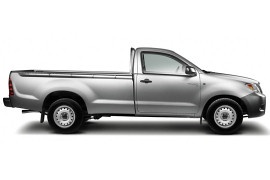
TOYOTA Hilux
Generations Timeline, Specs and Pictures

The 2006 Hilux SW4, also known as Toyota Fortuner, was first unveiled in 2005 and is the successor of the Toyota Hilux Sport Rider.
The 5-door SUV was initially addressed to the Asian, African and Latin American markets but some other countries got this new model, too. The Hilux SW4 is available in four engine versions, two gasoline and two diesel, ranging from 2.5 to 4.0 liter. Although the SW4 series initially included a four-wheel drive version powered by gasoline, the Japanese company discontinued the model and introduced a new two-wheel drive gasoline-powered edition in 2007.

After more than 12 million units sold until 2005, the HiLux was the second-best-selling nameplate in the Toyota lineup, after the Corolla.
Such a vital model deserved special attention from the carmaker. When it introduced the seventh generation in 2005, it tried to make the car friendlier as a family car, especially in the four-door version named Double-Cab. Toyota managed to do that without altering its legendary off-road abilities and reliability.
Along with the seventh generation, Toyota increased the pickup size again, and the Extra Cab was 105 mm (4.1”) longer than its predecessor and featured a 1,520 mm (5.9 ft) long bed, 165 mm (6.5”) longer than the sixth HiLux generation. At the front, it sported angular headlights with rounded lower and upper sides, ended into the corner-mounted turn signals.
Inside, the pickup couldn’t hide its utilitarian destination since the dashboard was made from hard plastic. Yet, the carmaker tried to make it look more civilized, with silver trims on the center stack. The instrument cluster featured a three-dial design, with a center-mounted speedometer and an LCD at the bottom for the odometer. Since Toyota built the Double-Cab version as a family vehicle as well, it installed a bench for three in the back.
Like all its predecessors, the 2005 HiLux was built on a ladder chassis, but it featured double-wishbone front suspension. For more comfortable rides, it sported a rack and pinion steering system. Under the hood, Toyota installed only one engine option, a 2.5-liter turbo-diesel, which offered 102 hp, which it paired it to a five-speed manual. Unusually, the LHD vehicles featured a standard Limited-slip differential. The HiLux Double-Cab was available in 4x2 configurations for specific markets, while the 4x4 version was typical for most countries.

Toyota sold the sixth generation of the HiLux in more than 12 million units, making it the second best-selling model from its lineup, before introducing the seventh generation in 2005.
Toyota built the 2005 HiLux with three cabin options: single, extra, and double. While the single-cab was designed mostly for hard work and the Double Cab was good for families, the Extra Cab was in the middle, providing a longer loading area than the top version and more seats than the base model.
Along with the seventh generation, Toyota increased the pickup size again, and the Extra Cab was 105 mm (4.1”) longer than its predecessor and featured a 1.805 mm (5.9 ft) long bed, almost one foot (285 mm) longer than its four-door brother. At the front, it sported angular headlights with rounded lower and upper sides, ended into the corner-mounted turn-signals.
Inside, the pickup couldn’t hide its utilitarian destination since the dashboard was made from hard plastic. Yet, the carmaker tried to make it look more civilized, with silver trims on the center stack. The instrument cluster featured a three-dial design, with a center-mounted speedometer and an LCD at the bottom for the odometer. In the back, Toyota installed two small jump-seats where someone could sit on short distances. To help them get more air, the carmaker installed pop-out windows.
Like all its predecessors, the 2005 HiLux was built on a ladder chassis, but it featured double-wishbone front suspension. For more comfortable rides, it sported a rack and pinion steering system. Toyota installed a choice of two engines for the Extra Cab version, including a new turbo-diesel with a common-rail injection that provided 102 hp. It offered it with a five-speed manual and a transfer case with high and low range.

Toyota introduced the seventh generation of the HiLux in 2005 and offered the single cab as the entry-level version for its successful pickup.
With over twelve million units sold from the HiLux sixth generation, the utility vehicle deserved more attention from its producer. The reliability was its supreme quality, and that was improved even more with the introduction of a stiffer, more rugged chassis built from high-strength steel. Despite being considered a compact pickup, it could carry one metric ton (2,204 lbs) without tearing a sweat.
Along with the seventh generation, Toyota increased the pickup size again, and the Singe Cab has featured the longest bed in its class with 2,340 mm (7.7’). At the front, it sported angular headlights with rounded lower and upper sides, ended into the corner-mounted turn-signals on the outer side, and sharp angles towards the grille. For the base trim level, Toyota offered the utility vehicle with black bumpers, door handles, and mirrors.
Toyota offered the Single Cab as a workhorse with hard plastic on the dashboard and synthetic fabric upholstery. On the base trim level, it featured cranked windows, no AC or audio system. For the top trim level, the carmaker included all of these and better upholstery.
Like all its predecessors, Toyota built the 2005 HiLux on a ladder chassis, but it featured double-wishbone front suspension. For more comfortable rides, it sported a rack and pinion steering system. Toyota installed a choice of two engines for the Singe Cab version, including a new turbo-diesel with a common-rail injection that provided 102 hp. It was available with 2WD and lower ground clearance or 4x4 with a high and low transfer case and increased ground clearance for demanding off-road situations.























































